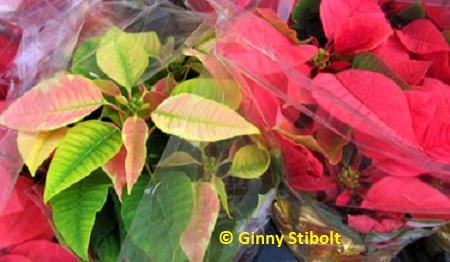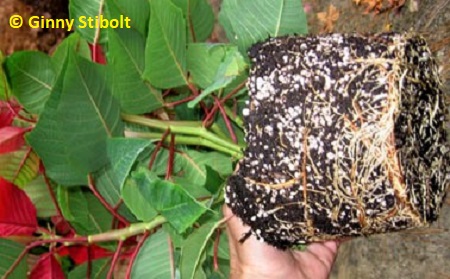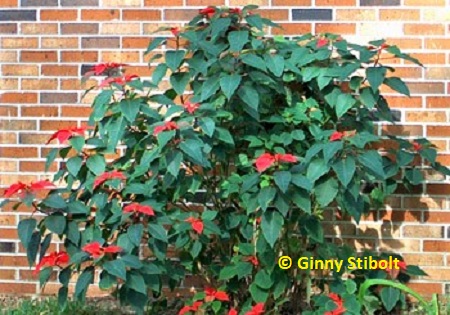Adventures of a Transplanted Gardener |
|||
Poinsettias are NOT poisonous
|
|||
 Pink and white bracts on poinsettias. |
The poinsettia (Euphorbia pulcherrima), a native of the Mexican desert near Cuernavaca, is the most popular potted plant in this country despite the fact that more than 90% are sold in just a six-week period. It's also one of the most mispronounced--the proper pronunciation is: poin-séh-ti-a.
The poinsettia is a member of the spurge family (Euphorbiaceae), which is often called the euphorbs (pronounced yóu-forbs). Like others in this large and varied family, poinsettias have a milky sap, but scientific tests of every part of the plant have shown that poinsettias are NOT poisonous to either humans or their pets.
It's typical of this family that the flowering heads contain small flowers with no petals that are arranged to mimic the form of a typical flower. The female flowers sit up on stalks and are surrounded by small male flowers. Below the flowers the modified and brightly colored leaves called bracts substitute as petals to attract pollinators to the flower.
In 1923, growers noticed that some of the poinsettias were dwarfed and had many more branches. Much later microbiologists at USDA found that dwarfing and free branching in poinsettias is a symptom caused by a virus. The interaction between the virus and poinsettia result in traits that poinsettia growers desire. It has provided a way to produce those multi-flowered Christmas showpieces--the basis of a $325 million annual industry.
 |
<< The poinsettias I bought were almost root-bound. It's good that I repotted them to hang on my front porch.
The care and feeding of poinsettias
Your poinsettia will look good in your home for couple of months or more if you purchase good quality plants and treat them right. If you shop for your plants at a florist or a reputable local nursery, you can buy them at any time during the season, but if you get your poinsettias from a big box store, purchase them as soon as you can before the staff mistreats them. Those colorful foil pot wrappers hold the water, so the plants often become waterlogged on the shelf.
Look for plants that are just beginning to bloom and choose those with three or more flowering heads. There are many colors these days, but the standard bright red is closest to the native plant and you may find that it will hold up the best. You shouldn't see much of the stem, because the leaves below the bracts should still be attached. Look at the roots to make sure they are not pot bound. You'll pay a premium for plants in bigger pots. I often buy small, inexpensive plants as soon as they are available after Thanksgiving, repot them into my own bigger pots, and let them grow a little before the holidays. I use them in my front porch hanging pots as part of the holiday décor.
Check the soil daily. Be sure to punch holes in foil, if you keep it, so water can drain. Set it in a saucer with some pebbles so the pot does not sit in the water. Water when the soil is dry because plants that have been allowed to wilt on a regular basis tend to drop their leaves and bracts sooner. Poinsettias last longest if the daytime temperatures are between 60 to 70 degrees and nighttime temperatures are around 55 degrees. Higher temperatures will shorten the plant's life, so make sure they get some shade from the late afternoon sun whether they are inside or outside.
Don't fertilize while in bloom. If you keep poinsettias past the holidays, you can treat them as a houseplant and use a mild, organic fertilizer such as fish or seaweed emulsion. If you plant them outside, use plenty of compost in the soil. They can grow into good-sized shrubs, depending upon the cultivar and where they are planted--here in northern Florida, it's best to plant them where it's warmest like next to building or a brick wall.
 |
My neighbor's poinsettias on the south side
of the house bloomed for many years. >>
Flowering is induced in the poinsettia when the nights are longer than the days. Without long nights, this plant will continue to grow and produce leaves but never flower. It must not be exposed to light from any source during the night--one flash will stop the whole process. You can try to accomplish this yourself by covering or closeting the plants to keep the plants in total darkness from 5pm to 8am every day starting the beginning of October to produce blooms in time for the holidays. Also, make sure the nighttime temperature is not above 75 degrees. If you've planted your poinsettias outside where there is natural lighting, you'll probably see blooming just in time for Christmas. Or you could just purchase new plants each year, like the rest of us.
How did the poinsettia become so popular?
In the 1820's President John Quincy Adams appointed Joel Roberts Poinsett as the first United States ambassador to Mexico. While in Mexico in 1828, Poinsett found a beautiful shrub with large red flowers growing next to a road. He took cuttings from the plant and sent them back to South Carolina. When he was home he worked propagation methods and gave them away to all his friends and botanical gardens. He sent one to his friend John Bartram in Philadelphia who passed his plant on to a nurseryman Robert Bluist, also of Pennsylvania. Bluist is credited with being the first to sell the plant.
In 1836 historian and horticulturist, William Prescott, suggested the common name, poinsettia, in honor of Poinsett's discovery and introduction of the plant. At that time Mr. Prescott had just published a book called the "Conquest of Mexico" in which he detailed Poinsett's discovery of the plant. Today, even though Poinsett had an outstanding career as a United States Congressman and as an ambassador to both Mexico and Russia, he's primarily remembered for introducing this plant into the United States.
In the early 1900s, Albert Ecke and his son Paul, immigrant fruit and dairy farmers in California, became interested in the poinsettia, and thought that it would be an ideal holiday flower to grow and sell. They started growing the poinsettias in fields, selling them at roadside stands in Hollywood and Beverly Hills. Paul traveled the country, promoting the poinsettia as a holiday flower and teaching growers all about the plant.
The Ecke family's advertising and education campaign to make the poinsettia a necessary part of the holiday season was successful. Other commercial growers got involved and the industry grew. Today there are commercial poinsettia growers in all 50 states, but California is still the top producer. The Ecke Ranch claims to have developed the breeding stock or the plants for 70 percent of all flowering poinsettias sold in the US and more than 50 percent sold in the rest of the world.
The christmas connection
Because of its Mexican origin, this plant doesn't have a long history of European traditional folk legends for Christmas, like mistletoe, holly, and ivy. Once the Spaniards moved into the region bringing their religion, various versions of the Christmas poinsettia legend arose. According to the Ecke Ranch website and others, it's the tale of poor children in Mexico picking some weeds to add to nativity scene at their churches because they couldn't afford to buy anything. When they laid down the green branches, miraculously, the green top leaves turned bright red and soon beautiful red star-like flowers surrounded the manger. From then on, the bright red flowers were called Flores de Noche Buena, or Flowers of the Holy Night.
December 12 is National Poinsettia Day and recognizes Poinsett's contribution to the holiday season. Whether you celebrate this day or not, enjoy your holiday season with these lovely Mexican desert plants that we've made our own.
Resources:
· University of Florida's Extension datasheet for poinsettias:
http://edis.ifas.ufl.edu/ep349.
· Perdue University's resources on poinsettias: https://ag.purdue.edu/department/btny/ppdl/potw-dept-folder/2021/poinsettia-poisonous-pets.html
· The San Diego Botanic Garden has information on Ecke and
poinsettias: www.sdbgarden.org/history-ecke-sr.htm
Ginny Stibolt is a life-long gardener, a botanist, a naturalist, and a garden writer. You may contact her or read more of her articles posted on her website: www.greengardeningmatters.com.
Copyright Ginny Stibolt

